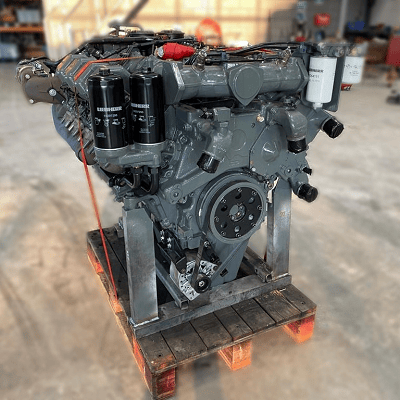The process of a dyno test on a Liebherr engine

When it comes to heavy machinery, reliability and power are paramount. Liebherr, a name synonymous with innovation and excellence in engineering, stands tall as a pioneer in the realm of heavy equipment and machinery. From towering cranes to robust excavators, Liebherr’s engineering prowess extends to the heart of these machines. We delve into the world of dyno testing a Liebherr engine, uncovering the meticulous process behind unleashing the raw power concealed within.
The foundation of excellence
Before we embark on the journey of dyno testing, it’s crucial to understand the foundation upon which Liebherr engines are built. With decades of engineering expertise and commitment to quality, Liebherr engines are crafted to withstand the most demanding environment and deliver unparalleled performance. Each component is meticulously designed and rigorously tested to ensure reliability, efficiency and longevity.
The process
1 Preparation: The engine undergoes meticulous preparation before being mounted onto the dynamo meter. This includes ensuring all connections are secure, fluids are filled to the appropriate levels, and sensors are properly calibrated.
2 Mounting: The engine is carefully mounted onto the dynamometer, a specialized device designed to simulate real-world operating conditions. Precision is paramount during this step to ensure accurate results.
3 Initial checks: Once mounted, a series of initial checks are conducted to verify proper alignment, connection integrity, and functionality of all engine systems.
4 Warm-up: The engine is started and allowed to warm up to operating temperature. This ensures consistent results and minimizes the risk of damage during testing.
5 Baseline testing: With the engine warmed up , baseline tests are conducted to establish initial performance metrics. This includes measuring power output, torque, fuel consumption, and emissions at various RPM levels.
6 Load testing: The engine is subjected to progressively increasing loads to simulate different operating conditions, such as idle, partial load and full load. This allows engineers to assess performance across the entire operating range and identify any potential issues or optimization.
7 Data analysis: Throughout the testing process, data is continuously collected and analyzed in real-time. Advanced instrumentation and software are used to monitor performance metrics and identify trends or anomalies.
8 Optimazation: Based on the data analysis, adjustments may be made to optimize engine performance. This could involve fine-tuning fuel injection timing, adjusting air-fuel ratios, or optimize turbocharger boost pressure.
9 Validation: Once testing is complete, the results are meticulously reviewed and validated against predetermined criteria and specifications. Any deviations or anomalies are thoroughly investigated to ensure accuracy and reliability.
10 Reporting: Finally, a comprehensive report is generated detailing the results of the dyno testing, including performance metrics, observations, and any recommendations for further optimization or refinement.
The outcome of dyno testing
Dyno testing a Liebherr engine is more than just a routine procedure – it’s a testament to the unwavering commitment to excellence that defines Liebherr’s engineering philosophy. By subjecting their engines to rigorous testing and analysis, Liebherr ensures that each engine delivers the uncompromising performance, reliability, and efficiency that customers expect.
In conclusion, dyno testing a Liebherr engine is not just about measuring power output. It’s about unlocking the true potential of these remarkable engines and ensuring they exceed expectations in the most challenging environments imaginable.
PPGI (Prepainted SteelCoil/Sheet/Strip)
PPGI stands for "Pre-Painted Galvanized Iron", which refers to a type of steel material that has been coated with a layer of paint or other protective coating before being formed into various products, such as roofing sheets, wall panels, and corrugated sheets. The pre-painting process helps to increase the durability and resistance of the steel against corrosion and other environmental factors. PPGI is commonly used in the construction industry for its strength, versatility, and aesthetic appeal.
-
The galvanized coating on PPGI provides excellent resistance to rust and corrosion, which is particularly important in areas with high humidity, salt spray, or industrial pollution.
-
PPGI is available in a wide range of colors and finishes, allowing architects and designers to create customized building facades and roofing systems that match their vision.
-
PPGI is easy to install and requires minimal maintenance. The pre-painted surface does not need to be painted or coated again, which saves time and costs associated with painting.
-
PPGI is lightweight yet strong, making it an ideal material for roofing and cladding applications. It is also highly resistant to impact and fire, which enhances the safety of the building.
-
PPGI can be recycled, which makes it an eco-friendly choice for sustainable construction. The steel can be melted down and reused to create new products, reducing the amount of waste sent to landfills.
Overall, PPGI is a versatile and reliable material that is widely used in the construction industry for its durability, aesthetics, and environmental benefits.
ppgi coil,color coated coil,PPGI STEEL COIL,color coated coil ppgi,ppgi prepainted galvanized steel coil
Wuxi Shengshu Metal Co., Ltd. , https://www.wuxissmetal.com